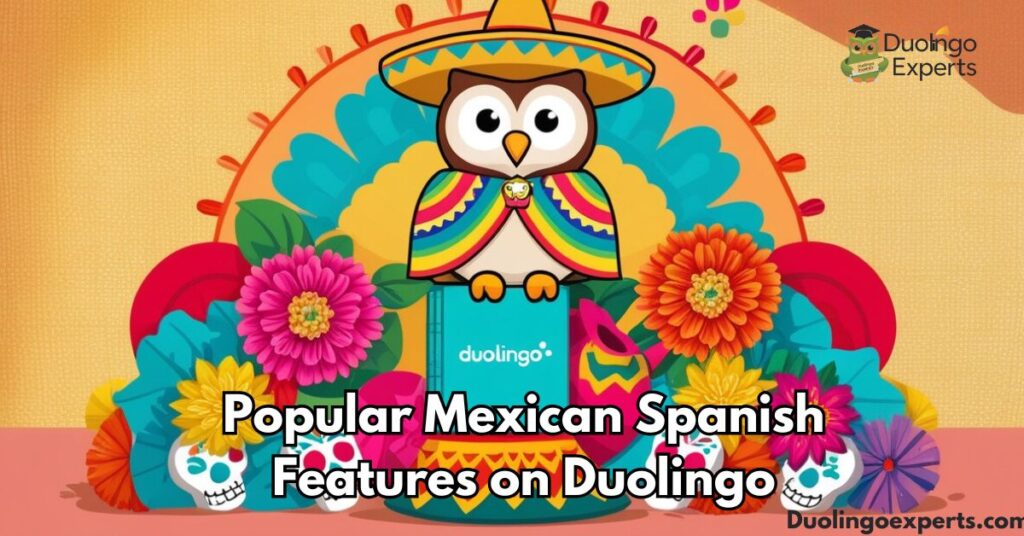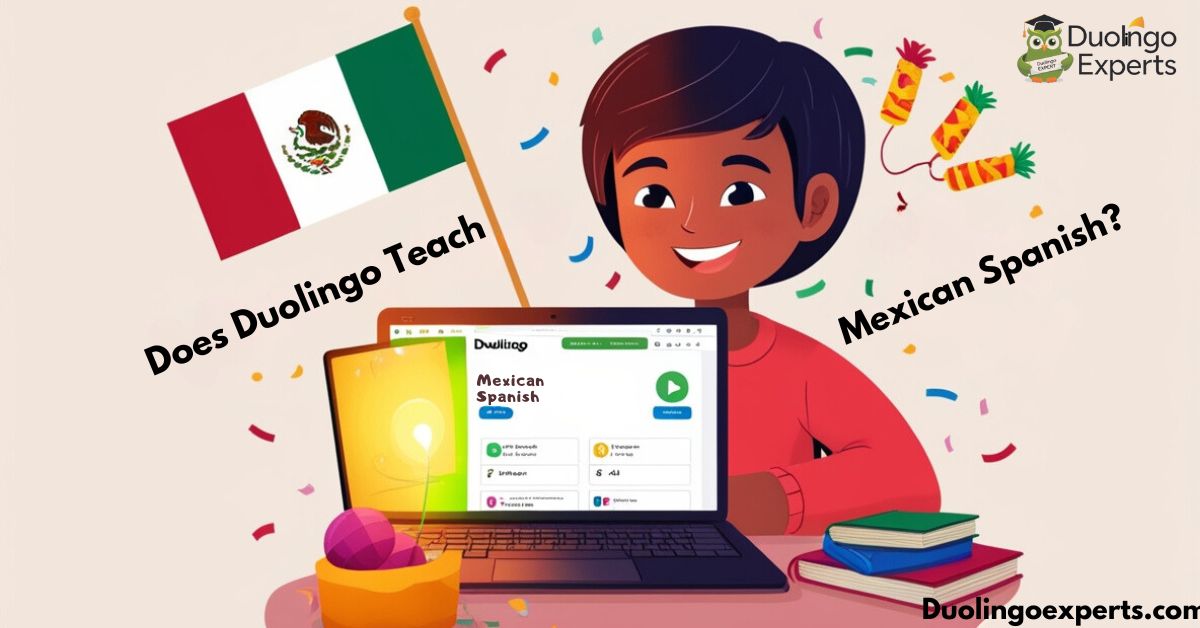Does Duolingo Teach Mexican Spanish ? Duolingo is widely recognized as one of the best tools for language learners, thanks to its intuitive interface, gamified approach, and accessibility. But one question that comes up frequently among Spanish learners is whether Duolingo teaches Mexican Spanish or offers a more generalized approach to Spanish language learning.
If you’re considering Duolingo to learn Mexican Spanish, you’ll want to understand how it handles regional dialects, the Mexican version of Spanish, and what makes it unique compared to other forms, such as Castilian Spanish from Spain.
In this comprehensive guide, we will delve deep into the nuances of Mexican Spanish as it appears on Duolingo, its key features, differences with other Spanish dialects, and effective strategies to maximize your learning experience.
Does Duolingo Teach Mexican Spanish?
Yes, Duolingo does teach Mexican Spanish, but it primarily focuses on Latin American Spanish, with a strong emphasis on the vocabulary and pronunciation commonly found in Mexico. However, as we dive deeper into this post, you’ll discover that Duolingo isn’t solely dedicated to teaching Mexican Spanish in isolation. Instead, the app gives learners a general understanding of Latin American Spanish, which spans a wide range of regional differences.
Latin American Spanish Focus
Duolingo’s Spanish course is heavily focused on Latin American Spanish due to the fact that the majority of Spanish speakers around the world are from Latin America. Within this course, the content largely draws from countries like Mexico, Colombia, Argentina, and Peru. The focus is intended to give learners the tools needed to communicate effectively across different Latin American dialects—with a heavy dose of Mexican Spanish vocabulary, expressions, and cultural references.
Duolingo recognizes that Spanish is not a monolithic language and that regional Spanish dialects have distinct features. For example, pronunciation, grammar structures, and vocabulary can vary significantly between Mexico and Spain. As a result, the app is designed to familiarize learners with these differences while centering on the most commonly used forms of the language in Latin America.
Mexican Spanish: What Makes It Unique?
Mexican Spanish has its own distinctive flavor. When you use Duolingo, you’ll encounter Mexican Spanish in its essential form, with its particular vocabulary, grammar choices, and regional expressions. But how does Duolingo incorporate these features?
Pronunciation
One of the first things you’ll notice when learning Mexican Spanish through Duolingo is the pronunciation. Mexican Spanish is known for its clarity and relatively neutral accent compared to Castilian Spanish. For example, the Mexican pronunciation avoids the Castilian “lisp” sound in words like “cielo” (sky) and “gracias” (thanks). Instead, Mexican Spanish pronounces these words with a straightforward “s” sound.
Duolingo helps learners grasp Spanish pronunciation through its use of native speaker recordings. These recordings give learners the opportunity to hear how Mexican Spanish should sound and practice alongside them. By focusing on native pronunciation, Duolingo ensures learners are exposed to authentic sounds that reflect the way Spanish is spoken in Mexico.
Vocabulary
In addition to pronunciation, Duolingo introduces learners to essential Mexican Spanish vocabulary that’s often different from other Spanish-speaking regions. Some words used in Mexican Spanish are either completely unique or have different meanings compared to Castilian Spanish. Here are a few examples:
| Mexican Spanish | Castilian Spanish | English Translation |
|---|---|---|
| Torta | Bocadillo | Sandwich |
| Camión | Autobús | Bus |
| Chido | Guay | Cool |
| Güey | Tío | Dude, Bro |
These vocabulary differences make Mexican Spanish distinctly its own, and Duolingo does a great job of integrating these local words into its lessons. Whether you’re ordering a torta at a local restaurant in Mexico or chatting with a güey, Duolingo provides useful vocabulary tailored to the Mexican experience.
Grammar
Mexican Spanish also differs in some grammatical aspects, particularly when it comes to pronouns. For example, in Castilian Spanish, the informal “you” is expressed with “vosotros” for plural use, but in Mexican Spanish, “ustedes” is used in both formal and informal situations. Duolingo focuses on this pronoun usage by reinforcing the more universal “ustedes” form, which is widely accepted across Latin America, including Mexico.
Duolingo Spanish Learning Methods

One of Duolingo’s most celebrated features is its gamified approach to language learning. By combining interactive exercises, spaced repetition, and adaptive learning, Duolingo keeps you engaged while reinforcing Mexican Spanish lessons effectively.
Gamification
Duolingo’s gamified approach makes learning Mexican Spanish enjoyable. You earn points, unlock new levels, and progress through different stages of language acquisition. This fun, game-like structure encourages consistent practice and turns the potentially tedious task of learning vocabulary and grammar into something more engaging. Through daily goals and achievements, learners remain motivated to continue their studies.
Spaced Repetition
Spaced repetition is one of Duolingo’s core learning principles. The app tracks your progress and adapts lessons based on what you need to review most. By reviewing previously learned words and grammar at increasing intervals, Duolingo ensures that you reinforce Mexican Spanish vocabulary and grammar lessons for better retention. This system is especially useful for mastering Spanish conjugation and sentence structure, two key elements of Mexican Spanish.
Native Speaker Recordings
To ensure learners master authentic Mexican Spanish pronunciation, Duolingo integrates native speaker recordings throughout its lessons. By listening to how words and phrases are spoken by native speakers, learners can perfect their accent and intonation. The inclusion of native speaker practice is particularly valuable when learning Mexican Spanish, as it helps users distinguish between regional accents and understand colloquial speech patterns.
Adaptive Learning
Duolingo’s adaptive learning system adjusts to each learner’s needs. If you’re struggling with certain concepts, Duolingo will review them more frequently until you feel confident. This personalized approach allows learners to proceed at their own pace and reinforces important Mexican Spanish elements like vocabulary, verb conjugations, and grammar.
Mexican Spanish vs. Castilian Spanish: Key Differences
Vocabulary
When it comes to Mexican Spanish, many vocabulary differences arise. These can be words that are unique to Mexico or have different meanings from Castilian Spanish. For example:
| Mexican Spanish | Castilian Spanish | English Translation |
|---|---|---|
| Chido | Guay | Cool |
| Chinga | Joder | A vulgar expletive |
| Platicar | Hablar | To talk, chat |
| Chela | Cerveza | Beer |
These differences help create the unique character of Mexican Spanish, and Duolingo does a good job of including these words in its lessons.
Pronunciation
Mexican Spanish is typically pronounced more clearly and with a simpler intonation than Castilian Spanish, which can be more nasal and influenced by the famous “lisp.” For example, “c” and “z” in Castilian Spanish are pronounced like “th” in “think”, but in Mexican Spanish, they are pronounced like a normal “s” sound. This makes Mexican Spanish more accessible to many learners who find the Castilian accent more challenging.
Grammar
One of the most notable grammatical differences between Mexican Spanish and Castilian Spanish is the use of vosotros. In Spain, vosotros is used for the informal second person plural (you all), but in Mexico and most of Latin America, ustedes serves as the second person plural, regardless of formality. This distinction is important for learners to grasp when mastering Mexican Spanish on Duolingo.
Popular Mexican Spanish Features on Duolingo

Duolingo includes many features that specifically highlight the Mexican dialect of Spanish. This includes key phrases, pronunciation guides, and cultural context that reflect Mexican Spanish as it’s used in everyday life.
Key Mexican Spanish Phrases
Here are some essential Mexican Spanish phrases that Duolingo introduces learners to:
- ¿Qué onda? (What’s up?)
- Chido (Cool)
- Güey (Dude, bro)
- ¡Ánimo! (Cheer up, let’s go!)
- ¿Mande? (Excuse me?)
Mexican Slang and Informal Expressions
Duolingo also teaches informal and colloquial expressions commonly used in Mexico. These include slang terms like:
- Chido (Cool, awesome)
- Güey (Dude, bro)
- Chela (Beer)
These informal terms help students grasp the nuances of Mexican Spanish as it’s used in social interactions.
Maximizing Your Spanish Learning on Duolingo

To make the most of Duolingo’s Spanish course, it’s essential to use a variety of language learning strategies. While Duolingo’s gamified approach is highly effective, you can combine it with other resources for faster language acquisition.
Additional Learning Tools
- Podcasts: Listen to the Duolingo Spanish Podcast for real-world conversations and cultural immersion.
- Spanish Media: Watch Mexican movies or shows with Spanish subtitles to further immerse yourself in Mexican culture and language.
- Practice with Native Speakers: Use platforms like HelloTalk or Tandem to interact with native Spanish speakers and improve your fluency.
Regular Practice
Consistency is key when learning Mexican Spanish. Set daily goals for Duolingo practice and make it part of your routine. This will ensure you build momentum and retain what you’ve learned.
Frequently Asked Questions
How does Duolingo incorporate Mexican Spanish?
Duolingo incorporates Mexican Spanish by emphasizing vocabulary, pronunciation, and grammar specific to Mexico, such as the use of “ustedes” for both formal and informal “you.” The app also teaches popular Mexican slang and everyday expressions, providing a culturally immersive experience.
What are the key differences between Mexican Spanish and Castilian Spanish?
Key differences include vocabulary (e.g., torta vs bocadillo), pronunciation (e.g., no lisp in Mexican Spanish), and grammar (e.g., use of ustedes instead of vosotros).
How effective is Duolingo for learning Mexican Spanish?
Duolingo is highly effective for beginners and intermediate learners who want to master the basics of Mexican Spanish, including pronunciation, grammar, and everyday vocabulary.
Does Duolingo Teach Mexican Spanish or Spain Spanish?
Duolingo primarily teaches Latin American Spanish, with a strong emphasis on Mexican Spanish in terms of vocabulary, pronunciation, and expressions. It avoids focusing heavily on Castilian Spanish from Spain, though some general Spanish grammar and structure are covered.
Does Duolingo have Mexican Spanish?
Yes, Duolingo offers Mexican Spanish as part of its Latin American Spanish course, focusing on vocabulary, pronunciation, and cultural context unique to Mexico. While it includes elements from other Latin American regions, the majority of content reflects Mexican Spanish.
Does Duolingo Teach Mexican Spanish or American?
Duolingo teaches Mexican Spanish, not American Spanish, as it focuses on the Spanish spoken in Mexico and other Latin American countries. The course emphasizes Mexican vocabulary, pronunciation, and regional expressions.
What Spanish does Duolingo Teach?
Duolingo teaches Latin American Spanish, with a strong emphasis on Mexican Spanish in terms of vocabulary, pronunciation, and expressions. The course covers key elements of Spanish grammar and regional differences across Latin America.
Conclusion
Duolingo is a fantastic tool for learning Mexican Spanish, offering an engaging, personalized learning experience that combines fun, interactive exercises with real-world language use. The app’s emphasis on Latin American Spanish provides a strong foundation in Mexican Spanish through relevant vocabulary, pronunciation, and cultural context. With consistent practice and the strategic use of additional resources, Duolingo can be a powerful tool to master Mexican Spanish.
>>>Read Also: How Long Does It Take to Learn Spanish on Duolingo?

DuolingoExperts, managed by MarkJohan, offers expert insights and tips for mastering languages. A tech-driven platform to enhance your learning experience.

